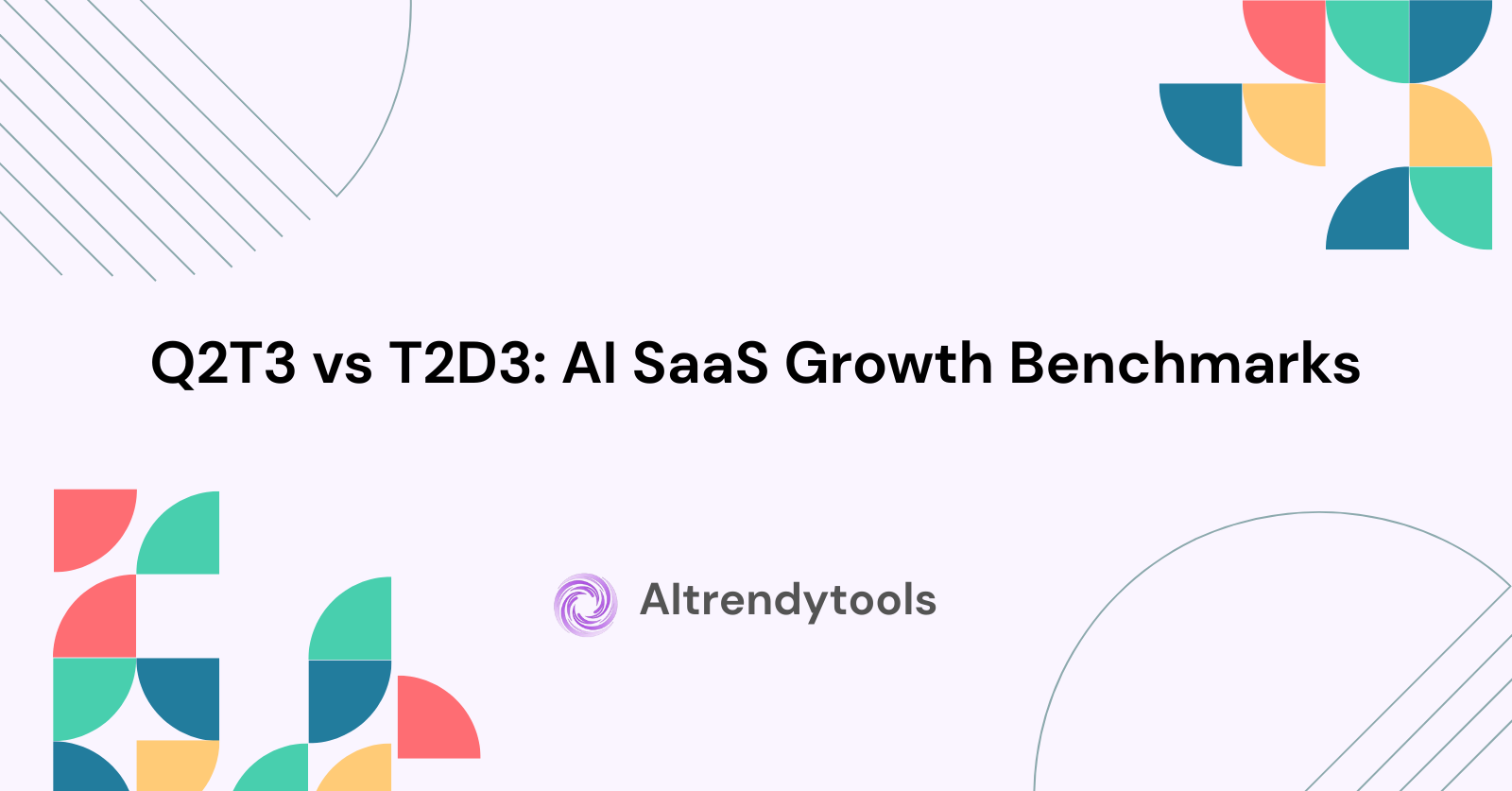🔥 AITrendytools: The Fastest-Growing AI Platform |
Write for usQ2T3 vs T2D3: AI SaaS Growth Benchmarks
Learn how Q2T3 replaces T2D3 as the new growth benchmark for AI startups. Discover how AI-powered SaaS companies reach $100M ARR in 4 years vs 6
Oct 20, 2025
The startup landscape has entered a new era where traditional growth models no longer capture the explosive potential of AI-powered companies. A revolutionary benchmark has emerged that reflects this seismic shift in how fast startups can scale.
Q2T3 represents the new standard for AI-native SaaS companies. This aggressive growth framework replaces the older T2D3 model that defined success during the traditional SaaS era. Understanding these benchmarks is critical for founders, investors, and executives navigating the AI revolution.
Understanding the T2D3 Growth Framework
T2D3 stands for Triple, Triple, Double, Double, Double. This framework became the gold standard for SaaS companies seeking venture capital and aiming for unicorn status.
The T2D3 progression works as follows:
- Year 1: Triple your revenue from ~$2M to $6M
- Year 2: Triple again to reach $18M ARR
- Year 3: Double to $36M ARR
- Year 4: Double to $72M ARR
- Year 5: Double to $144M ARR
Nate Maddrey championed this framework in the mid-2010s. The model gained widespread adoption among venture capitalists evaluating SaaS investments. Companies like Shopify, Zendesk, and Atlassian followed similar trajectories during their growth phases.
T2D3 demanded significant capital investment. Sales teams needed expansion, marketing budgets grew substantially, and the approach prioritized market share capture through aggressive spending. Many companies burned through hundreds of millions in venture funding to achieve these growth rates.
What is Q2T3 Growth Model
Q2T3 stands for Quadruple, Quadruple, Triple, Triple, Triple. Bessemer Venture Partners introduced this benchmark in their State of AI 2025 report, published in August 2025.
The Q2T3 growth trajectory:
- Year 1: Quadruple from ~$3M to $12M ARR
- Year 2: Quadruple to $48M ARR
- Year 3: Triple to $144M ARR
- Year 4: Triple to $432M ARR
- Year 5: Triple to over $1B ARR
This trajectory compresses the path to $100 million ARR into approximately four years. T2D3 typically requires five to six years to reach the same milestone. The difference represents a fundamental shift in what's possible for AI-native companies.
Bessemer analyzed ten high-growth AI "shooting stars" to develop this framework. These companies demonstrated growth patterns that made traditional SaaS hypergrowth look sluggish.
AI Startup Growth Metrics Revolution
AI has transformed how quickly companies can scale. Development cycles that once took months now complete in weeks. Product iterations happen at unprecedented speeds.
Key advantages AI provides:
- Automated customer support handling thousands of conversations simultaneously
- AI-powered lead qualification without human SDRs
- Intelligent onboarding flows reducing implementation time
- Self-service capabilities that scale infinitely
Traditional SaaS companies relied heavily on human capital. Customer support teams grew linearly with customer bases. Sales organizations expanded proportionally with revenue targets.
AI-powered companies operate differently. The capital efficiency gains are remarkable. A company achieving Q2T3 growth might employ 200 people where a T2D3-era company needed 500.
Annual Recurring Revenue Benchmarks for AI Companies
ARR remains the critical metric for subscription businesses. The path to $100 million ARR separates good companies from exceptional ones. This milestone typically unlocks institutional investor interest and validates product-market fit at scale.
Critical ARR milestones comparison:
- $10M ARR: Q2T3 reaches in Year 1; T2D3 in Year 2
- $50M ARR: Q2T3 reaches in Year 2-3; T2D3 in Year 3-4
- $100M ARR: Q2T3 reaches in Year 4; T2D3 in Year 5-6
First-mover advantages matter more in fast-moving markets. An extra year of growth means an extra year capturing customers, refining the product, and building network effects. The company reaching $100 million faster often dominates the market category.
Investor expectations have shifted accordingly. A pitch deck showing T2D3 projections might have impressed investors in 2020. The same projections today signal a lack of ambition or understanding of AI's potential.
Revenue Growth Trajectory Differences
T2D3 companies typically start with strong initial traction. The first triple represents validation of problem-solution fit. The second triple confirms the ability to scale go-to-market motions.
The growth curve resembles a hockey stick. Early years show explosive percentage growth on smaller bases. Later years require billions in revenue additions to maintain double-digit percentage growth.
Q2T3 demands even higher execution standards:
- Quadrupling revenue twice requires extraordinary execution
- Product-market fit, distribution, and operations must excel simultaneously
- Year 3 tripling means adding $96M in new ARR in one year
- Year 4 tripling requires adding $288M in incremental revenue
Most traditional software companies never reach $288 million in total revenue. Q2T3 companies add that figure annually during their tripling phase.
AI-Native Startups vs Traditional SaaS
Product development cycles differ dramatically between these company types. Traditional SaaS teams spend months gathering requirements, designing features, and building functionality.
AI-Native Development Advantages:
- Model fine-tuning in days rather than weeks
- Continuous A/B testing with AI optimizing variations automatically
- Real-time product improvement based on usage patterns
- Faster iteration cycles compress time to product-market fit
Customer acquisition looks different too. Traditional SaaS relied on outbound sales teams, content marketing, and paid advertising. The CAC often exceeded $5,000 for enterprise software.
AI products often sell themselves through viral mechanisms. The AI assistant that one employee uses impresses colleagues. Word spreads organically. Some AI tools integrate into workflows so seamlessly that adoption happens without formal procurement processes.
Venture Capital Expectations for AI Startups
Investors have recalibrated their mental models for AI investments. A Series A company showing 3x year-over-year growth might have been impressive in 2019. The same metrics today might struggle to generate partner enthusiasm at top firms.
What investors look for now:
- Product-market fit with clear AI differentiation
- Path to Q2T3-style growth trajectory
- Strong unit economics and capital efficiency
- Technical moats that are difficult to replicate
- Team with proven AI expertise
Q2T3 has become the aspirational framework for AI pitches. Founders present projections showing quadruple growth in early years. Investors evaluate whether the team, product, and market can deliver on those ambitions.
Some investors warn about bubble dynamics. Sam Altman has cautioned that "someone's gonna get burned" in the AI investment frenzy. Nobody has actually achieved full Q2T3 growth yet because AI startups are so new.
Product-Market Fit in the AI Era
Finding product-market fit remains essential regardless of the growth framework. AI doesn't eliminate the need for deep customer understanding and solving real problems.
AI-native companies can test hypotheses more quickly. Launch a feature, measure engagement, adjust the model, and repeat. This tight feedback loop compresses the time to find what resonates with customers.
Signs of AI product-market fit:
- Organic viral adoption without paid marketing
- Users expressing genuine "wow" moments
- High engagement rates with core AI features
- Strong NPS scores (40+)
- Low churn rates (<5% monthly)
The definition of "fit" may differ for AI products. Users increasingly expect intelligent features as table stakes. A CRM without AI-powered insights feels outdated.
This dynamic creates opportunities for AI-native challengers. Incumbent solutions built in the pre-AI era feel clunky by comparison. The window for new entrants has reopened in many categories.
Scaling Strategies for Hypergrowth Startups
Achieving Q2T3 growth requires different scaling strategies than T2D3. The traditional playbook emphasized building sales organizations, establishing partner ecosystems, and creating extensive customer success teams.
AI-enabled scaling strategies:
- One CSM serving 500 accounts using AI monitoring tools
- Sales reps focusing on strategic accounts while AI handles long tail
- Automated expansion identification and proactive outreach
- Self-service models for SMB and mid-market segments
Infrastructure must scale accordingly. Traditional SaaS platforms might buckle under 4x usage growth. AI-native architectures anticipate explosive scaling from day one.
Team composition changes as well. AI companies hire more ML engineers and fewer SDRs. Product managers need technical depth to work with model performance. The skill mix reflects the different value creation mechanisms.
Revenue Scaling Challenges and Solutions
Quadrupling revenue presents unique challenges. Customer acquisition needs to 4x while maintaining or improving unit economics. The product must handle 4x scale without breaking.
Common scaling challenges:
- Product reliability suffering under unexpected load
- Support quality degrading with rapid customer expansion
- Company culture diluting as headcount doubles annually
- Technical debt accumulating faster than it can be addressed
- Leadership team struggling to manage larger organization
AI provides new tools for managing scaling challenges. Predictive models identify infrastructure bottlenecks before they cause outages. Automated monitoring catches quality issues earlier.
The path to Q2T3 requires excellent execution across all functions simultaneously. A weakness in any area can derail the entire growth trajectory.
AI-Driven Product Development Cycles
Traditional software development follows waterfall or agile methodologies. Requirements gathering takes weeks. Design and development consume months. Testing and QA add more time.
AI transforms product development:
- Models updated continuously without discrete releases
- Features improve through ongoing training automatically
- Bug fixes deployed in hours instead of weeks
- New capabilities launched days after identifying needs
The competitive implications are significant. AI-native companies can outmaneuver traditional competitors through superior agility. By the time an incumbent plans a feature response, the AI startup has already iterated three generations beyond the initial release.
This enables much faster value delivery to customers. The product evolves constantly based on usage patterns and feedback signals.
Bessemer Venture Partners' AI Analysis
Bessemer's State of AI 2025 report marked a watershed moment in framing AI startup expectations. The firm analyzed growth patterns across their portfolio and the broader AI ecosystem.
Key findings from the report:
- Ten "shooting star" companies identified with Q2T3+ growth
- Strong correlation between AI-native architecture and growth speed
- Capital efficiency improved 3-4x compared to traditional SaaS
- Product-led growth motions work better with AI products
- Time to $100M ARR compressed by 18-24 months
Bessemer's analysis carries weight in the venture community. The firm's SaaS practice has generated exceptional returns over decades. Their frameworks and benchmarks influence how other investors evaluate opportunities.
The timing matters too. Released in August 2025, it comes as AI investments reach fever pitch. The framework provides structure for evaluating hundreds of AI startups competing for attention and capital.
Investor Requirements for AI Company Funding
Raising capital as an AI startup now requires demonstrating a path to Q2T3-style growth. Series A investors want to see product-market fit and early traction suggesting quadruple growth is achievable.
Due diligence focuses on:
- Model performance metrics and training efficiency
- Defensibility of AI advantages and technical moats
- Quality of training data and data acquisition strategy
- Team's AI expertise and relevant experience
- Unit economics and path to profitability
Valuations reflect Q2T3 expectations. Companies on track for this growth trajectory command premium multiples. A business growing at 2x or 3x might struggle to attract top-tier investors even with solid fundamentals.
This dynamic creates risk for founders. Raising at high valuations based on Q2T3 projections commits the company to delivering exceptional results. Missing targets can trigger down rounds and founder dilution.
Building Capital-Efficient AI Businesses
Capital efficiency separates good AI companies from great ones. Achieving Q2T3 growth while maintaining reasonable burn rates creates powerful outcomes for founders and investors alike.
Levers for capital efficiency:
- Build on foundation models instead of training from scratch
- Implement efficient inference approaches to reduce compute costs
- Use product-led growth instead of traditional enterprise sales
- Automate customer acquisition through viral mechanisms
- Leverage community-driven adoption and word-of-mouth
Smart architectural choices matter enormously. Using efficient inference approaches reduces compute costs. Thoughtful data strategies minimize storage and processing expenses.
Go-to-market efficiency proves equally important. Product-led growth motions cost less than traditional enterprise sales. Strategic partnership integrations provide distribution without dedicated sales teams.
Future Growth Frameworks Beyond Q2T3
Q2T3 won't be the final evolution in growth benchmarks. Future technological shifts will enable even more aggressive scaling trajectories.
The pattern suggests that each major platform shift enables roughly 30-50% faster growth trajectories. PC software gave way to internet software, which yielded to mobile, then SaaS, and now AI.
Potential future frameworks:
- Q3T2: Quadruple three times, then triple twice
- Q4T1: Quadruple four times, then triple once
- Even more aggressive growth models for breakthrough technologies
The limiting factor may shift from technology to market size. At some point, companies scale so fast they exhaust addressable markets before the growth curve predicts.
Implementing Q2T3 in Your AI Startup
Achieving Q2T3 growth requires deliberate strategy and flawless execution. Founders must build the right foundation, hire exceptional talent, and maintain intense focus on what drives results.
Product excellence checklist:
- AI capabilities deliver genuine, differentiated value
- Viral growth mechanisms designed into the product
- Self-service onboarding that requires no human touch
- Real-time performance monitoring and optimization
- Continuous improvement based on usage data
Go-to-market essentials:
- Identify highest-leverage distribution channels
- Double down on what works, eliminate what doesn't
- Every team member understands their role in hitting targets
- Measure leading indicators that predict future performance
- Optimize conversion rates at every funnel stage
Operational discipline requirements:
- Implement systems supporting 4x growth before reaching that scale
- Invest in infrastructure and monitoring proactively
- Automate everything that doesn't require human judgment
- Build robust incident response and recovery processes
- Maintain product reliability as usage explodes
Team building makes everything possible. Hire people who thrive in chaotic, fast-moving environments. Look for candidates with relevant experience scaling companies through hypergrowth phases.
Frequently Asked Questions About Q2T3 and T2D3
What does Q2T3 stand for?
Q2T3 stands for Quadruple, Quadruple, Triple, Triple, Triple. It represents a growth framework where AI startups quadruple revenue in years one and two, then triple revenue in years three, four, and five.
How is Q2T3 different from T2D3?
Q2T3 is more aggressive than T2D3. Q2T3 companies reach $100M ARR in about 4 years versus 5-6 years for T2D3. The initial growth rates are higher (4x vs 3x), reflecting AI's ability to scale faster than traditional SaaS.
Has any company actually achieved Q2T3 growth?
No company has completed the full Q2T3 journey yet because the framework is so new. Bessemer identified ten "shooting star" companies tracking toward Q2T3-level growth, but AI startups are still too young to have completed the five-year trajectory.
Is T2D3 still relevant for non-AI companies?
T2D3 remains highly relevant for traditional SaaS companies. Not every software business will be AI-native, and T2D3 still represents exceptional growth for most SaaS models. The framework you target should match your company's capabilities and market.
What's the biggest challenge in achieving Q2T3 growth?
Maintaining product reliability and team cohesion while quadrupling revenue is extremely difficult. Most companies struggle with operational execution at that pace. The technical infrastructure must scale perfectly, and the team must grow without losing culture or effectiveness.
How much capital do you need to achieve Q2T3?
AI companies generally require less capital than traditional SaaS to hit the same revenue milestones due to better unit economics. However, exact amounts vary widely based on market, business model, and go-to-market strategy. Many Q2T3-track companies raise $50-100M through Series B.
What role does AI play in enabling Q2T3 growth?
AI enables Q2T3 through automation, capital efficiency, and faster product development. AI handles customer support, lead qualification, onboarding, and other functions that previously required human labor, allowing companies to scale revenue faster than headcount.
Should every AI startup target Q2T3?
Not necessarily. Q2T3 represents the upper bounds of what's possible for the fastest-growing AI companies. Most startups should focus on strong fundamentals, product-market fit, and sustainable growth rather than chasing an extremely aggressive benchmark they may not achieve.
Conclusion
The artificial intelligence revolution has fundamentally altered what's possible for startup growth. Q2T3 represents this new reality better than frameworks from the traditional SaaS era. Companies that understand and execute against this benchmark position themselves for exceptional outcomes.
The path to Q2T3 is not easy. It demands excellent products, efficient go-to-market, operational excellence, and some good fortune. Most companies will fall short. Those that succeed will define the AI-native category leaders for the next decade.
Founders and investors navigating this landscape need to understand both frameworks deeply. T2D3 remains relevant for traditional SaaS businesses and provides useful context. Q2T3 sets the bar for AI-powered companies with ambitions to dominate their markets. Choose the right benchmark for your specific situation and execute relentlessly against it.
🚀 Submit Your Tool to Our Comprehensive AI Tools Directory
Get your AI tool featured on our complete directory at AITrendytools and reach thousands of potential users. Select the plan that best fits your needs.





Join 30,000+ Co-Founders
Related Blogs
TechMapz Com: 7 Reasons It's Your Best Tech Hub
Discover TechMapz com the ultimate technology hub for gadget reviews, AI trends, cybersecurity tips, and tech news. Explore features that make it stand out in 2025.
Sci Hub: 10+ Free Alternatives to Access Research Papers
Discover Sci Hub alternatives and 10+ legal ways to access research papers free. Complete guide to scientific journals, open access, and academic resources.
Picverse AI Review: Create Stunning Images in Seconds
Discover how Picverse AI transforms text into stunning visuals. Features, pricing, pros & cons everything you need to know about this AI image generator.
Submit Your Tool to Our Comprehensive AI Tools Directory
List your AI tool on AItrendytools and reach a growing audience of AI users and founders. Boost visibility and showcase your innovation in a curated directory of 30,000+ AI apps.





Join 30,000+ Co-Founders

